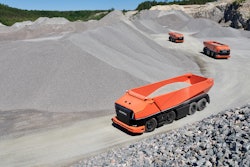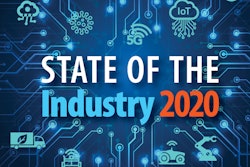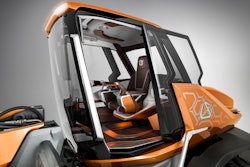
responses submitted by Jay Iyengar, Chief Technology Officer, CNH Industrial
Diesel, Electric & Other Power Alternatives
How does your company see alternative fuels playing a role in the heavy equipment industry in the coming years?
The heavy equipment industry is changing. We can see three main trends shaping the future powertrain ecosystem: New regulations, evolving customer requirements, and novel technologies. We are entering a new era where tightening emission rules and raised awareness of climate change have demanded alternative solutions – and we are leading the way. We have a wide portfolio of alternative propulsion systems which include compressed and liquified natural gas (CNG and LNG respectively), battery and fuel cell electrification, and hybrids thereof.
We continue to focus on natural gas, as this technology is already today a realistic and widely available alternative, which reduces CO2 emissions by up to 92% versus diesel when using biomethane, or even negative values when generating it from manure. Natural gas not only reduces CO2 emissions, but also nitrogen oxides by up to 65%, particulates by up to 98% and noise levels by up to 80% compared to diesel. Natural gas also brings total cost of ownership advantages due to lower fuel cost compared to diesel.
Our New Holland Agriculture T6 Methane Power tractor is a great example of how we incorporate economic and environmental advantages in our equipment. The T6 Methane Power tractor can even achieve near-zero CO2 emissions: if farmers use agricultural waste from their own operation to generate biomethane to fuel the tractor, it will lead to a true circular economy.
The industry will continue to evolve, and natural gas will continue to have its place depending on the customer duty cycles. We also see alternative energy sources such as batteries and hydrogen playing a role in off-highway applications as the technology and infrastructure progresses.
What role is electrification—or other alternative energy/power systems—playing in your company’s design initiatives?
Electrification is gaining momentum across the heavy equipment sector. The key benefits are reduction of CO2 emissions, better controllability, instantaneous high torque, noise reduction and increased operator ease. When used with renewable energy sources, it is the only technology with the potential to be zero-carbon from well-to-wheel and also carbon-neutral from tank-to-wheel. Thus, we look at various ways how to move this technology forward in a sustainable way.
One of our main initiatives is part of our truck business. We have taken a disruptive approach by teaming up with Nikola. Our joint efforts to accelerate industry transformation towards emission neutrality of Class 8 heavy-duty trucks in North America and Europe through the adoption of fuel cell technology is a game-changer for the sustainability of heavy-duty truck emissions.
Through our partnership with Nikola, we are bringing the first fuel cell truck to the market: the battery electric NIKOLA TRE is based on the new IVECO S-WAY heavy-duty truck platform and integrates Nikola’s proprietary technology. IVECO and Nikola are the first to target road transport decarbonization by the combination of BET (Battery Electric Truck) from 2021 and FCET (Fuel Cell Electric Truck) from 2023.
Another notable initiative is ProjectZeus, the 580 EV, from our construction brand CASE. This first electric TLB was launched at this year’s CONEXPO in Las Vegas. It is an environmentally friendly and economically sustainable solution for construction equipment. It has zero exhaust emissions and significantly lower noise levels than a standard TLB which makes it ideal for use in cities and densely populated areas. We expect the 580 EV to be in high demand by utilities, utility contractors, and government and municipal operations that are incentivized to run equipment with alternative fuel sources, as well as contractors in states such as New York, California and Florida with strict emissions standards and incentives for alternative fuel use.
Another concept projects relates to the company’s European agricultural brand, the STEYR Konzept. This innovative concept tractor uses a modular hybrid electric drive, comprising a combustion engine, a generator, and several electric motors, which can be controlled individually, and which then supply energy where it is needed. This use of flexible electrification as a way to make the tractor more efficient and deliver power exactly where needed, also delivers greater overall sustainability.
Are there any emissions or other related regulations your company is monitoring, or feel will have an impact on design efforts and the industry?
One of our main drivers is sustainability: CNH Industrial’s commitment to sustainability is a long-term priority. We have set key targets to align with the United Nations’ Sustainable Development Goals (SDGs), one of those being climate action. Therefore, we are continuously pushing the boundaries of what’s possible with clean energy and alternative fuel solutions and are committed to creating a better tomorrow through innovation. Sustainability initiatives are embedded in all areas of our business and are common denominators of our corporate strategy. With regards to product design and manufacturing, our ambition is to become carbon neutral and deliver fully recoverable lifecycle thinking. This ambition is also reflected in our corporate purpose of ‘Powering Sustainable Transformation’.
Given that diesel engines are facing tightening emissions regulations and challenges, we focus on new technologies and refining existing solutions not only for an era that may follow diesel, but also for the years of transition that lie ahead. We need to be in a position to offer a range of alternative propulsion systems to meet the needs of our customers best.
As far as other regulations, safety has been a top priority for CNH Industrial. With the wide adoption of digital technologies and automation, both in the on- and off-highway industries, we are also focused on functional safety and cyber security as a part of the core competency adopting standards such as NIST (National Institutes of Standards and Technology). This is a new emerging area for regulations which we continue to monitor closely.
Data, IoT & Connectivity
How will the role of the Internet of Things (IoT) and data continue to progress in the coming years?
Digital technology provides exciting possibilities for machine automation and remote monitoring. Embedded electronics, new sensors and data analytics methods (AI/ML) allow you to automate more and more key machine functions, leading to full automation and autonomously operating intelligent vehicles. Connectivity is an enabler for remote monitoring and data collection creating new business opportunities such as precision farming, gathering machine operational and performance data, agronomic data and sending data to the machine to control the operations to enable new “machine as a service” models. In summary, benefits of IoT and data analysis are limitless. They are centered around efficiency, cost savings, decision making, and operator enhancement. To use agriculture as an example: We can monitor nearly every aspect of a farming operation, whether it be tillage, planting, spraying, or harvesting. Data collection and digital tools allow us to reduce waste and improve crop management. We can also maximize available labor and input resources and track performance. At the end of a crop season, we can use our yields to determine how to approach the next season. IoT and big data will shape the industry in the years to come.
Do you see a path toward the use of AI, VR or AR in your manufacturing processes, or even on-board the vehicle itself?
Adoption of any technology is centered around value creation and these are at different stages of maturity on the road-map, but rapidly growing.
I see AI (artificial intelligence) having a broad application in many areas for our products, both on-board and off-board, especially in providing actionable insights from large data sets. It’s not the data but its analysis and resulting insights that matter, and to that end, the application of AI is limitless starting from diagnostics and prognostics to advanced machine controls. In agriculture, we see AI as a foundational need to drive full agronomy. We are also seeing the benefit of AI in manufacturing processes especially in quality management and operational efficiency.
VR (virtual reality) and AR (augmented reality) technologies have an immediate application for remote services, repair and training of service and manufacturing personnel. We are also seeing an increased use in the area of customer experience: for example, we can simulate an interactive cab environment for customers which can help them in their decision-making process before purchasing the vehicle. In our manufacturing plants, we are beginning to apply these technologies for operator training, process control, etc. as a part of our Industry 4.0 transformation. We are also increasing the application of AR/VR technologies in product development with the ability to create a “real world” digital twin prior to proceeding with the detailed design.
READ MORE: Simulated Reality Brings Real-World Results
How do you see connectivity and machine learning changing the vehicle landscape in the next decade?
I predict that every product over the next decade will be connected and “intelligent”, with a large amount of electronics and software content.
The majority of our new products are digitally born and connected. We plan to develop a comprehensive suite of digital and connectivity services to help our customers run their operations with increased efficiency. Servitization which describes this rise of “as a service” offerings is a key technology-driven trend we have identified.
The movement towards managing data will continue. We’ve just begun to realize the value of data when making operational decisions. The more that is collected, the better our customers can perform. However, we also realize that this data is only of value if our customers have the tools to interpret it and make real-world and timely decisions based on the data being generated.
With regards to agriculture, data collection will influence real-time agronomic decisions as well as future planning. We can learn how to address a plant’s specific needs based on soil type, nutrients, and moisture. We can optimize logistics by monitoring fleet and farm asset location and performance. Moreover, we can anticipate changes to soil conditions and plant threats before they occur. Ultimately, we can determine what has been effective and ineffective in producing higher, more sustainable yields.
What challenges remain or lay ahead for the continued adoption of data, IoT and connectivity related technologies or systems?
While big data allows farmers to be more productive and to analyze their farm operations in many ways, there are the same data privacy concerns like in other areas of modern life. Farmers want to know why data is collected, how it is used and if it is shared with other parties. To this end, CNH Industrial is committed to ensuring that our customers remain in full control of their data, and the company adopts an ‘opt-in’ policy as standard.
Another area is UX/UI (User Experience and User Interface). As products become more complex, an intuitive product design is key to create a seamless human-machine interface and to help create an emotional connection to the product.
In the age of digital transformation, technologies like IoT put the customer at the center of the value creation. Thus, we need to take an integrated and holistic approach to customer service meaning that customers have to be brought in early in the process – as seen with the data privacy and UI/UX examples above.
Automation & Smart Systems
What impacts are you seeing automation playing on the heavy equipment and vehicle industries?
We will see strategic actions to incorporate more autonomy into daily farming operations as well as robotic and drone technology. Growers are often faced with the challenge of time, operational windows, and a dwindling labor force. To maximize output, autonomy will become an integral part of their operation.
The use of autonomy is also growing in the on-road semi-truck segment, the first step of which is platooning, something our commercial vehicles brand IVECO has also participated in in Europe. Increasing autonomy in the on-highway segment will be heavily influenced by that in passenger cars.
What do you see as the “next big thing” in automation and smart systems?
Big data is still the next big thing, more specifically, the data-driven agronomy. As the global agriculture analytics market is predicted to grow rapidly, we will develop more and better ways to analyze and share data between the sensors, the equipment and the farmer. In fact, the transfer and analysis of real-time data between machines (e.g. tractor on the field, drones for imaging) and other information sources (e.g. weather data, soil analysis) will be key to further implement autonomy in farming operations.
READ MORE: State of the Industry 2020
Challenges & Opportunities
What are some of the biggest opportunities you see in the industry?
Our ability to drive transformation through technology depends on the speed with which we bring solutions to the market in a targeted way so that customers can see the value immediately. At CNH Industrial, we do believe that open innovation and partnerships become critical to ensure speed and co-create customer value. Transformation of the technical skills of the industry as a whole, not just in product development, but the full value chain including supply chain, sales, maintenance and service is needed to ensure adoption and we have a great opportunity to transform the overall image of the company towards becoming a high-tech industry.
The main challenges in any new technology is wide market adoption. Key to driving adoption is to remain focused on the customer, continuously providing additional value by addressing their spoken and unspoken needs while managing product costs and reliability. To this end, it is important to think about modularity, create building blocks of technology which can be progressively deployed with incremental features and functions. With the rapid pace of progression of underlying core technologies, the challenge is to make sure the solutions do not become obsolete.
Are there any technologies or trends which you are currently excited about in the heavy-duty vehicle industry, or most looking forward to seeing in the coming years?
The ability to make an impact and tackle some of the mega challenges highlighted in the United Nations’ Sustainable Development Goals, such as Zero Hunger & Climate Action with technology is a very powerful and an endearing thought. The industry is on the brink of transformation leveraging advancements in computing power, electronics, big data, AI/ML, drones, sensing and other digital solutions. I look forward to a broad application of IoT connected solutions, continued advancement in battery and fuel cell technologies to enable increased adoption of electrification and emergence of new “as a service” business models. We live in an Amazon world and if you think about it, all the technologies that are usually present in a traditional high-tech industry are here in our industry today. Personally, I am excited to be a part of this technology-driven transformation.



















